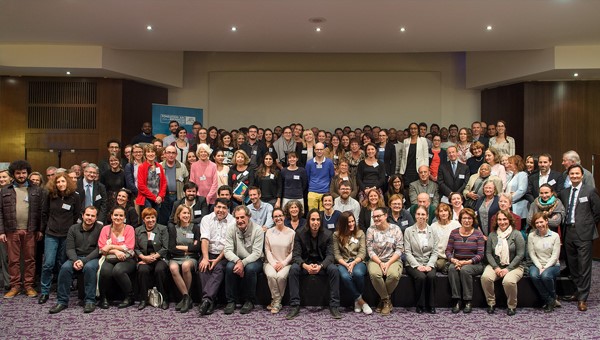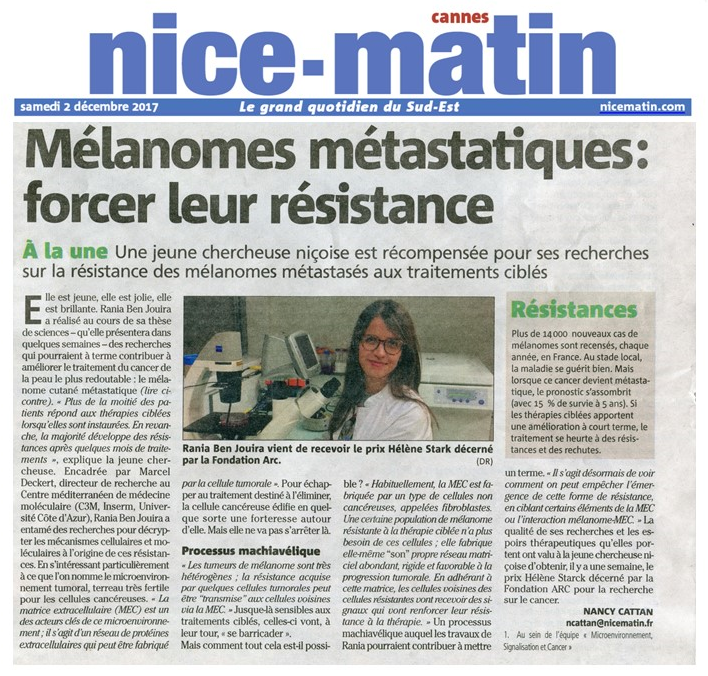-
Labex PhD Student Prize
Highlight on Rania Ben Jouira’s ARC Foundation Prize
Rania Ben Jouira, 2013 Labex PhD Student. Team Sophie Tartare Deckert, Centre Méditerranéen de Médecine Moléculaire (C3M). PhD project title : Microenvironment, signaling and cancer.
Press : Nice-Matin
Young Researcher ARC Foundation Prize (Association pour la Recherche sur le Cancer), Hélène Starck Prize : Jury Prize to Rania Ben Jouira, for her oral presentation « Extracellular matrix produced by BRAF inhibitor-resistant melanoma cells promotes therapeutic resistance to drug-sensitive cells »On Thursday, November, 16, and Friday, November 17, 2017, were held the ARC Foundation’s 21st Young Researchers Days. Nearly 200 participants, including more than 100 young researchers, contributed to this event. These days presented the perfect opportunity for the numerous and rich exchanges on the different fields of research in oncology.
Related links:
-
2017 Labex Publication
Highlight on one 2017 Labex Publication
Yue JX, Li J, Aigrain L, Hallin J, Persson K, Oliver K, Bergström A, Coupland P, Warringer J, Lagomarsino MC, Fischer G, Durbin R, Liti G
Nat Genet. 2017 Apr 17. doi: 10.1038/ng.3847. [Epub ahead of print]
PMID: 28416820
https://www.ncbi.nlm.nih.gov/pubmed/28416820
Impact Factor: 31.6
Team Gianni LITI « Population genomics and complex traits »French media
http://www.cnrs.fr/insb/recherche/parutions/articles2016/g-liti.html
Nat Genet. 2017 Jun;49(6):913-924. doi: 10.1038/ng.3847. Epub 2017 Apr 17
New sequencing tools give up close look at yeast evolution
Ever since the Austrian monk Gregor Mendel’s famous pea plant experiment 150 years ago, scientists have embarked a century-long endeavor to illuminate how the genetic information encoded in our DNAs gets translated into the vast diversity of phenotypes — the physical expression of our genetic information. Thanks to the rapid progress of DNA sequencing technology, we can now easily sequence our DNAs by chopping it into millions of small pieces and sequencing them at massive scale. However, to place back those sequenced small pieces is no easy task, much like solving a jigsaw puzzle with missing pieces and several pieces that can fit at the same place. In particular, there are many regions along our DNAs enriched with complex structural rearrangements that are difficult to resolve using short-read sequencing technology. As a result, many such complex regions still remain as black boxes, despite accumulating evidence suggesting their important implications in adaptation and disease susceptibility.
The recent advent of long-read sequencing technology has proven to be quite powerful in producing complete genome assemblies with many complex regions correctly resolved for a single reference genome. Here, an international consortium led by Jia-Xing Yue and Gianni Liti took this to the next level. They sequenced 12 representative strains from the partially domesticated baker’s yeast (Saccharomyces cerevisiae) and its closest wild relative (Saccharomyces paradoxus) to generate the first set of population-level end-to-end genome assemblies. By systematically comparing these complete genome sequences both within and between species, they were able to accurately capture structural genome dynamics along the evolutionary history of these two species and revealed the striking contrasts between them, many of which likely explained by the intimate association between the baker’s yeast and human activities. Moreover, the regions locate near the two ends of chromosomes (known as “subtelomeres”) are evolving very fast with frequent structural rearrangements. This study provided the first accurate definition for these regions and illuminated their excessive evolutionary dynamics with unprecedented resolution. Finally, they further exemplified how the fully resolved structural rearrangements in those complex regions could help to illuminate complex traits. All the high-quality genome assemblies and annotations generated by this study are shared to the public and the scientific community, which will serve as population-level reference genomes to guide future genomic and functional studies. This study represents another milestone in eukaryotic genomics and will pave the road towards a better understanding of genotype-phenotype relationship. Human cancer cells are also known for elevated structural rearrangements and genome reshuffling. As the next step, this consortium is planning to apply long-read sequencing technology to human tumor tissues to pinpoint the genetic drivers of genome instability, which may reveal new targets for anti-cancer drug development.
PMID:28416820PMCID:PMC5446901[Available on 2017-10-17]DOI:10.1038/ng.3847
- Home
- Research
- Science News
- Innovation
- PhD/Post-docs
- Organization







